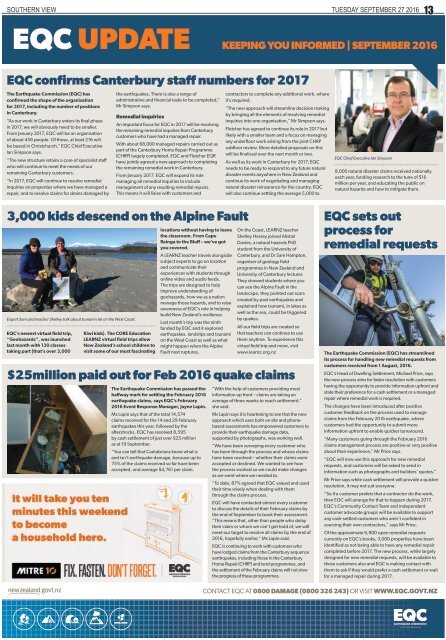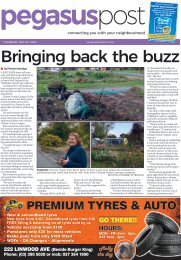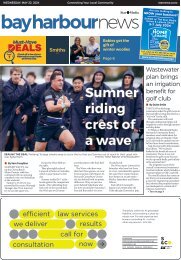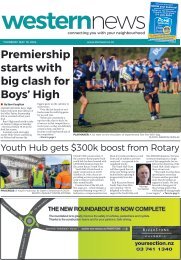Southern View: September 27, 2016
You also want an ePaper? Increase the reach of your titles
YUMPU automatically turns print PDFs into web optimized ePapers that Google loves.
SOUTHERN VIEW Tuesday <strong>September</strong> <strong>27</strong> <strong>2016</strong> 13<br />
EQC UPDATE KEEPING YOU INFORMED | SEPTEMBER <strong>2016</strong><br />
EQC confirms Canterbury staff numbers for 2017<br />
The Earthquake Commission (EQC) has<br />
confirmed the shape of the organisation<br />
for 2017, including the number of positions<br />
in Canterbury.<br />
“As our work in Canterbury enters its final phase<br />
in 2017, we will obviously need to be smaller.<br />
From January 2017, EQC will be an organisation<br />
of about 458 people. Of these, at least 216 will<br />
be based in Christchurch,” EQC Chief Executive<br />
Ian Simpson says.<br />
“The new structure retains a core of specialist staff<br />
who will continue to meet the needs of our<br />
remaining Canterbury customers.<br />
“In 2017, EQC will continue to resolve remedial<br />
inquiries on properties where we have managed a<br />
repair, and to resolve claims for drains damaged by<br />
the earthquakes. There is also a range of<br />
administrative and financial tasks to be completed,”<br />
Mr Simpson says.<br />
Remedial inquiries<br />
An important focus for EQC in 2017 will be resolving<br />
the remaining remedial inquiries from Canterbury<br />
customers who have had a managed repair.<br />
With about 68,000 managed repairs carried out as<br />
part of the Canterbury Home Repair Programme<br />
(CHRP) largely completed, EQC and Fletcher EQR<br />
have jointly agreed a new approach to completing<br />
the remaining remedial work in Canterbury.<br />
From January 2017, EQC will expand its role<br />
managing all remedial inquiries to include<br />
management of any resulting remedial repairs.<br />
This means it will liaise with customers and<br />
contractors to complete any additional work, where<br />
it’s required.<br />
“The new approach will streamline decision making<br />
by bringing all the elements of resolving remedial<br />
inquiries into one organisation,” Mr Simpson says.<br />
Fletcher has agreed to continue its role in 2017 but<br />
likely with a smaller team and a focus on managing<br />
any underfloor work arising from the joint CHRP<br />
subfloor review. More detailed proposals on this<br />
will be finalised over the next month or two.<br />
As well as its work in Canterbury for 2017, EQC<br />
needs to be ready to respond to any future natural<br />
disaster events anywhere in New Zealand and<br />
continue its work of negotiating and managing<br />
natural disaster reinsurance for the country. EQC<br />
will also continue settling the average 5,000 to<br />
EQC Chief Executive Ian Simpson<br />
8,000 natural disaster claims received nationally<br />
each year, funding research to the tune of $16<br />
million per year, and educating the public on<br />
natural hazards and how to mitigate them.<br />
3,000 kids descend on the Alpine Fault<br />
Expert Sam and teacher Shelley talk about tsunami risk on the West Coast.<br />
EQC’s newest virtual field trip,<br />
“Geohazards”, was launched<br />
last month with 130 classes<br />
taking part (that’s over 3,000<br />
Kiwi kids). The CORE Education<br />
LEARNZ virtual field trips allow<br />
New Zealand’s school children to<br />
visit some of our most fascinating<br />
locations without having to leave<br />
the classroom. From Cape<br />
Reinga to the Bluff – we’ve got<br />
you covered.<br />
A LEARNZ teacher travels alongside<br />
subject experts to go on location<br />
and communicate their<br />
experiences with students through<br />
online video and audio feeds.<br />
The trips are designed to help<br />
improve understanding of<br />
geohazards, how we as a nation<br />
manage those hazards, and to raise<br />
awareness of EQC’s role in helping<br />
build New Zealand’s resilience.<br />
Last month’s trip was the ninth<br />
funded by EQC and it explored<br />
earthquakes, landslips and tsunami<br />
on the West Coast as well as what<br />
might happen when the Alpine<br />
Fault next ruptures.<br />
On the Coast, LEARNZ teacher<br />
Shelley Hersey joined Alistair<br />
Davies, a natural hazards PhD<br />
student from the University of<br />
Canterbury, and Dr Sam Hampton,<br />
organiser of geology field<br />
programmes in New Zealand and<br />
University of Canterbury lecturer.<br />
They showed students where you<br />
can see the Alpine Fault in the<br />
landscape, they pointed out scars<br />
created by past earthquakes and<br />
explained how tsunami, in lakes as<br />
well as the sea, could be triggered<br />
by quakes.<br />
All our field trips are created so<br />
that teachers can continue to use<br />
them anytime. To experience this<br />
virtual field trip and more, visit<br />
www.learnz.org.nz<br />
$25million paid out for Feb <strong>2016</strong> quake claims<br />
The Earthquake Commission has passed the<br />
halfway mark for settling the February <strong>2016</strong><br />
earthquake claims, says EQC’s February<br />
<strong>2016</strong> Event Response Manager, Jayne Lapin.<br />
Ms Lapin says that of the total 14,574<br />
claims received for the 14 and 29 February<br />
earthquakes this year, followed by the<br />
aftershocks, EQC has resolved 8,595<br />
by cash settlement of just over $25 million<br />
as at 19 <strong>September</strong>.<br />
“You can tell that Cantabrians know what is<br />
and isn’t earthquake damage, because up to<br />
75% of the claims received so far have been<br />
accepted, and average $4,761 per claim.<br />
“With the help of customers providing most<br />
information up front – claims are taking an<br />
average of three weeks to reach settlement.”<br />
she said.<br />
Ms Lapin says it is heartening to see that the new<br />
approach which uses both on site and phonebased<br />
assessments has empowered customers to<br />
provide their earthquake damage data,<br />
supported by photographs, was working well.<br />
“We have been surveying every customer who<br />
has been through the process and whose claims<br />
have been resolved – whether their claims were<br />
accepted or declined. We wanted to see how<br />
the process worked so we could make changes<br />
as we went where we needed to.<br />
“To date, 87% agreed that EQC valued and used<br />
their time wisely when dealing with them<br />
through the claims process.<br />
EQC will have contacted almost every customer<br />
to discuss the details of their February claims by<br />
the end of <strong>September</strong> to book their assessment.<br />
“This means that, other than people who delay<br />
their claim or whom we can’t get hold of, we will<br />
meet our target to resolve all claims by the end of<br />
<strong>2016</strong>, hopefully earlier,” Ms Lapin said.<br />
EQC is continuing to work with customers who<br />
have lodged claims from the Canterbury sequence<br />
earthquakes, including those in the Canterbury<br />
Home Repair (CHRP) and land programmes, and<br />
the settlement of the February claims will not slow<br />
the progress of these programmes.<br />
EQC sets out<br />
process for<br />
remedial requests<br />
The Earthquake Commission (EQC) has streamlined<br />
its process for handling new remedial requests from<br />
customers received from 1 August, <strong>2016</strong>.<br />
EQC’s Head of Dwelling Settlement, Michael Price, says<br />
the new process aims for faster resolution with customers<br />
having the opportunity to provide information upfront and<br />
state their preference for a cash settlement or a managed<br />
repair where remedial work is required.<br />
The changes have been introduced after positive<br />
customer feedback on the process used to manage<br />
claims from the February <strong>2016</strong> earthquake, where<br />
customers had the opportunity to submit more<br />
information upfront to enable quicker turnaround.<br />
“Many customers going through the February <strong>2016</strong><br />
claims management process are positive or very positive<br />
about their experience,” Mr Price says.<br />
“EQC will now use this approach for new remedial<br />
requests, and customers will be asked to send in<br />
information such as photographs and builders’ quotes.”<br />
Mr Price says while cash settlement will provide a quicker<br />
resolution, it may not suit everyone.<br />
“So if a customer prefers that a contractor do the work,<br />
then EQC will arrange for that to happen during 2017.<br />
EQC’s Community Contact Team and independent<br />
customer advocate groups will be available to support<br />
any cash-settled customers who aren’t confident in<br />
sourcing their own contractors,” says Mr Price.<br />
Of the approximate 6,900 open remedial requests<br />
currently on EQC’s books, 3,000 properties have been<br />
identified as not being able to have any remedial repair<br />
completed before 2017. The new process, while largely<br />
designed for new remedial requests, will be available to<br />
these customers also and EQC is making contact with<br />
them to ask if they would prefer a cash settlement or wait<br />
for a managed repair during 2017.<br />
CONTACT EQC AT 0800 DAMAGE (0800 326 243) OR VISIT WWW.EQC.GOVT.NZ


















